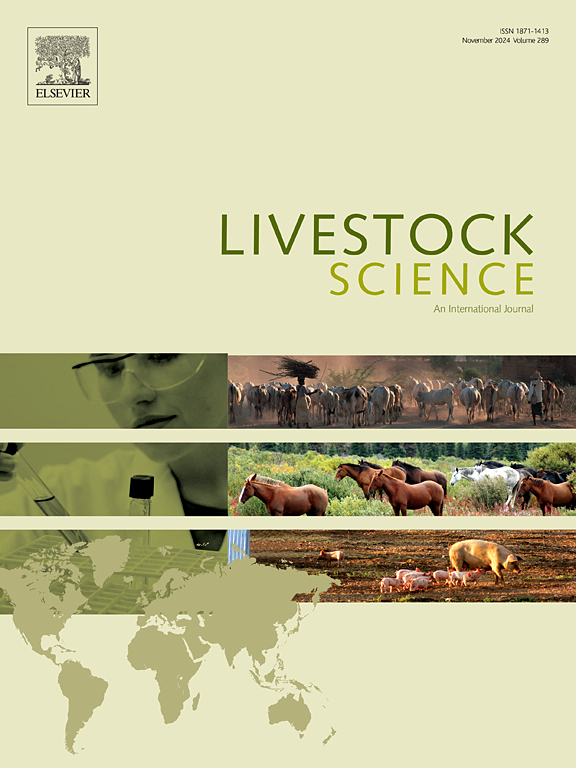Environmental assessment and mitigation strategies for dairy cattle farms in Colombia: Greenhouse gas emissions, non-renewable energy use, and land use
IF 1.8
3区 农林科学
Q2 AGRICULTURE, DAIRY & ANIMAL SCIENCE
引用次数: 0
Abstract
In Colombia, cattle farming is responsible for 15 % of national greenhouse gas emissions (GHGE), consequently, it is crucial to develop mitigation strategies that can reduce their climate impact. Using a Life Cycle Assessment approach, this study quantified the environmental burdens of 192 specialized dairy systems and determined mitigation strategies. Carbon footprint (CF), land use, and non-renewable energy use were calculated by applying the 2019 Refinement to 2006 IPCC guidelines and impact factors. The functional units considered were one kilogram of fat and protein corrected milk (FPCM) and one kilogram of live weight gain (LWG) from a cradle-to-farm-gate perspective. The findings revealed that enteric fermentation and manure left in pastures were the primary sources of on-farm GHGE, while feed manufacturing contributed significantly to off-farm emissions. Milk CF values ranged between 0.6 to 3.9 kg CO2-eq kg FPCM−1 when the biological allocation method was applied. Through clustering analysis, three farm clusters were identified, with Cluster 1 demonstrating higher milk productivity, better paddock and cattle manageability, and improved environmental behavior compared to the other clusters. The adoption of improved pastures as a mitigation strategy resulted in a significant reduction of milk CF by 20 % to 39 %. This study provides evidence supporting the effectiveness of mitigation strategies such as the inclusion of improved pastures, adoption of good cattle management practices, improvements in fertilizer usage, identification of an adequate stocking rate, and enhancement of milk yields in dairy production systems. These reductions in GHGE intensities can be achieved with a negative economic cost, highlighting the potential for sustainable and economically viable cattle farming practices.
哥伦比亚奶牛场的环境评估和缓解战略:温室气体排放、不可再生能源使用和土地使用
在哥伦比亚,养牛业占全国温室气体排放量的15%,因此,制定能够减少其气候影响的减缓战略至关重要。采用生命周期评估方法,本研究量化了192个专业乳制品系统的环境负担,并确定了缓解策略。碳足迹(CF)、土地利用和不可再生能源使用通过将2019年的精细化应用于2006年IPCC指南和影响因子来计算。考虑的功能单位是1公斤脂肪和蛋白质校正乳(FPCM)和1公斤活增重(LWG),从摇篮到农场大门的角度来看。研究结果表明,肠道发酵和牧场粪便是农场温室气体排放的主要来源,而饲料生产对农场温室气体排放有显著贡献。采用生物分配法时,牛奶CF值在0.6 ~ 3.9 kg CO2-eq kg FPCM−1之间。通过聚类分析,确定了三个农场集群,与其他集群相比,集群1具有更高的产奶量,更好的围场和牛的管理,以及更好的环境行为。采用改良牧场作为缓解战略,导致牛奶CF显著减少20%至39%。本研究提供的证据支持缓解战略的有效性,如纳入改良牧场、采用良好的牛管理规范、改善肥料使用、确定适当的放养率以及提高乳制品生产系统的产奶量。温室气体强度的这些降低可以以负的经济成本实现,突出了可持续和经济上可行的养牛业做法的潜力。
本文章由计算机程序翻译,如有差异,请以英文原文为准。
求助全文
约1分钟内获得全文
求助全文
来源期刊

Livestock Science
农林科学-奶制品与动物科学
CiteScore
4.30
自引率
5.60%
发文量
237
审稿时长
3 months
期刊介绍:
Livestock Science promotes the sound development of the livestock sector by publishing original, peer-reviewed research and review articles covering all aspects of this broad field. The journal welcomes submissions on the avant-garde areas of animal genetics, breeding, growth, reproduction, nutrition, physiology, and behaviour in addition to genetic resources, welfare, ethics, health, management and production systems. The high-quality content of this journal reflects the truly international nature of this broad area of research.
 求助内容:
求助内容: 应助结果提醒方式:
应助结果提醒方式:


